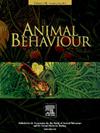雌雄同株鸟类雄性性行为和雌性抵抗力的昼夜模式
IF 2.3
2区 生物学
Q2 BEHAVIORAL SCIENCES
引用次数: 0
摘要
在一个日周期内,性行为的最佳时机是交配和繁殖成功的关键因素。然而,很少有研究在性选择和性冲突的背景下探讨交配行为的昼夜节律。在这里,我们描述了在室外围栏中自由互动的圈养红丛林鸡群体中,雌性交配接受性的昼夜节律模式以及雄性交配和求偶行为的频率。我们的研究表明,在为期 10 天的交配试验中,雄性性行为的模式和雌性对交配尝试的抵抗力在早晨和傍晚有所不同。在清晨,雌性对雄性交配尝试的抵制程度逐渐降低,而在傍晚,雌性对雄性交配尝试的抵制程度逐渐增加。雄性的交配频率与雌性的接受度并不一致,雄性在傍晚更频繁地开始交配尝试,但往往在早晨进行更多的求偶表演。雄性的行为模式与社会地位有关,占优势的雄性比处于从属地位的雄性更频繁地向雌性求爱,尤其是在早晨。然而,我们并没有发现雄性社会地位与不同时间策略相关的有力证据。这些结果表明了红色丛林鸟多种性行为的昼夜节律模式,可能会对该物种的性选择和近亲家禽的福利管理产生影响。本文章由计算机程序翻译,如有差异,请以英文原文为准。
Circadian patterns in male sexual behaviour and female resistance in a polygynandrous bird
The optimal timing of sexual behaviours across a daily cycle can form a key component of mating and reproductive success. However, few studies have explored circadian rhythms in mating behaviour within the context of sexual selection and sexual conflict. Here we characterized circadian patterns in female receptivity to mating and the frequency of male mating and courtship behaviours in freely interacting captive groups of red junglefowl, Gallus gallus, in outdoor enclosures. We showed that patterns of male sexual behaviour and female resistance to mating attempts differ between the morning and evening during a 10-day mating trial. Females progressively reduced their level of resistance to male mating attempts during the early hours of the morning and progressively increased their resistance in the evening. Males did not match their mating frequencies to female receptivity and initiated mating attempts more often in the evening, but tended to perform more courtship displays in the morning. The pattern of male behaviour was associated with social status, such that dominant males courted females more often than subordinates, particularly in the morning. However, we did not find strong evidence that male social status was associated with different timing strategies. These results demonstrate circadian patterns in multiple sexual behaviours in red junglefowl, with potential consequences for sexual selection in this species and welfare management in domestic populations of closely related fowl.
求助全文
通过发布文献求助,成功后即可免费获取论文全文。
去求助
来源期刊

Animal Behaviour
生物-动物学
CiteScore
4.60
自引率
8.00%
发文量
236
审稿时长
10.2 weeks
期刊介绍:
Growing interest in behavioural biology and the international reputation of Animal Behaviour prompted an expansion to monthly publication in 1989. Animal Behaviour continues to be the journal of choice for biologists, ethologists, psychologists, physiologists, and veterinarians with an interest in the subject.
 求助内容:
求助内容: 应助结果提醒方式:
应助结果提醒方式:


